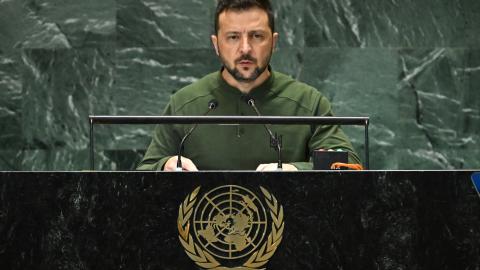Ukrainian President Volodymyr Zelensky’s visit to New York last week focused on much more than just addressing the UN General Assembly.
A war in Ukraine that many expected to last only a few days in February 2022 has turned into a grinding conflict measured instead in years, and Zelensky knew this visit to America was one of the most important since the Russian invasion.
As a former comedian and actor, he understands the power of communication. During his visit, Zelensky delivered important messages to three audiences: the American people, the international community, and US leaders
His first stop was a munitions manufacturing plant in Pennsylvania, where he met workers producing artillery rounds for Ukraine’s armed forces. The main purpose of this visit was to personally thank those working tirelessly to arm Ukraine. Even though it was not the intention, this stop had political implications. In the 2020 presidential election, Joe Biden narrowly beat Donald Trump in Pennsylvania by 80,000 votes. It is a swing state, home to about 800,000 Ukrainian Americans. Kamala Harris has run television ads there emphasizing her support for Ukraine. Meanwhile Trump has been increasingly critical of aid to Ukraine, making Zelensky’s visit seem to some like an indirect endorsement of Harris. From a logistical perspective, Pennsylvania’s proximity to New York and Washington DC made it a logical stop for Zelensky. Although his visit was not intended as an interference in US domestic politics, the significance of Pennsylvania with the election weeks away inevitably sparked debate.
In New York, Zelensky delivered a passionate speech to the General Assembly outlining Russia’s violations of the UN Charter. He used the platform to promote his 10-point Peace Formula to end the war. The proposal addresses key issues such as respecting Ukraine’s borders, ensuring nuclear safety, securing global food exports, and holding Russia accountable for war crimes. Notably, this remains the only concrete diplomatic proposal on the table.
A crucial aspect of Zelensky’s time in New York was his outreach to leaders from the Global South, many of whom are neutral in the war or sympathetic toward Russia: in a UN vote in March 2022 condemning Russia’s invasion, many abstained or voted against. They view the war less as Russian aggression and more as a proxy conflict between Russia and the West. Zelensky’s challenge was to convince them that Ukraine’s fight was one of national survival, not a mere battleground for competing global powers.
Zelensky’s final major stop was Washington, where he met President Joe Biden at the White House. The primary objective was to reinforce Ukraine’s strategic needs and emphasize the importance of continued US support. Zelensky revealed his long-awaited “victory plan” to Biden, though few details have emerged. One of his key requests was for the US to lift restrictions on Ukraine’s use of long-range weapons against military sites in Russia. So far Biden has been cautious, fearing an escalation of the conflict. From Ukraine’s perspective, this allows Russia to launch air raids from within its territory with little fear of retaliation.
The military rationale behind this restriction is debated: many experts argue that Ukraine should be allowed to attack airfields that threaten its cities. We do not know if Biden agreed to Zelensky’s request, but the meeting did yield significant other outcomes, including one of the largest single aid packages for Ukraine. Also, next month Biden will convene a meeting of about 50 countries in Germany to discuss and coordinate more military aid to Ukraine. Usually this would chaired by the US defense secretary, so it is notable that the president will do so.
Observers have also noted a subtle but significant shift in the language used by the Biden administration about Ukraine. Instead of saying the US will support Ukraine “for as long as it takes,” the White House now says it will provide Ukraine with “the support it needs to win this war.” The previous phrase had been criticized as ambiguous and lacking a clear goal. Whether the new language represents a more focused commitment to helping Ukraine achieve victory remains to be seen.
Despite the additional aid and Ukraine’s recent battlefield success in Kursk, Ukraine’s situation remains dire, especially as US domestic politics evolve. Regardless of the election’s outcome, Ukraine faces challenges. Trump has expressed skepticism about continued aid and has suggested Ukraine may need to cede territory to Russia in a peace deal. On the Democratic side, Harris has yet to articulate a comprehensive strategy for Ukraine if she wins. So far, her position aligns with Biden’s — supporting Ukraine enough for it to survive but without taking the bolder actions needed for Kyiv to win decisively.
Zelensky’s visit came at a critical moment in the war. But unless there is a drastic change in US thinking, which seems unlikely, 2025 will be a difficult year for Ukraine.
Enjoyed this article? Subscribe to Hudson’s newsletters to stay up to date with our latest content.
















